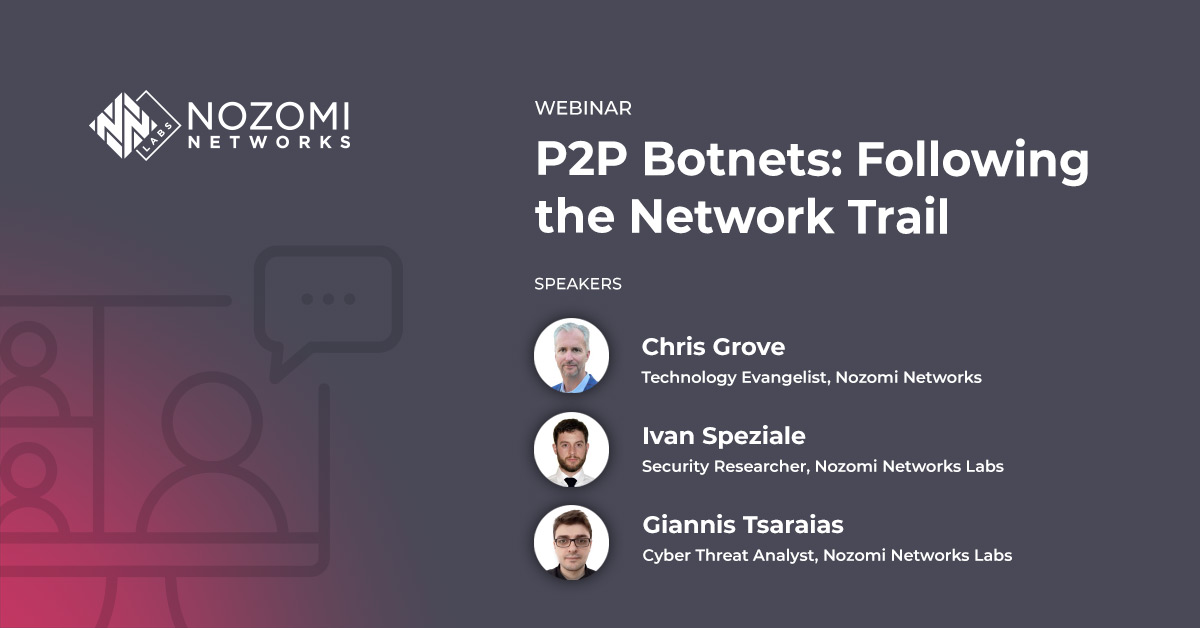In the first six months of 2020, the Mozi, DDG and FritzFrog botnets were very active, and exhibiting some pretty interesting behaviors.
Threat actors use peer-to-peer (P2P) botnets like these to build a platform that can later be used to carry out malicious operations, such as large-scale Distributed Denial of Service (DDoS) or mining for crypto currencies.
Early-generation botnets followed a client-server model for command and control (C&C), making use of popular protocols like IRC and HTTP, or implementing custom ones. However, the simplicity of this architecture offered little resilience.
Analyzing the new architectural designs of recent botnets can help us understand emerging botnet techniques, and how to use network artifacts to detect and mitigate their activity.
Recent Evolution of Botnet Platforms
One of the first countermeasures taken by botnet operators to address the architectural weaknesses involved relying on so-called bulletproof hosting. In laymen’s terms, it meant finding a hosting provider willing to turn a blind eye to client activity.
A second, often complementary solution involved using Domain Generating Algorithms (DGAs) as failsafes for situations where the C&C became unreachable. This technique consisted of embedding an algorithm within the bot to generate a series of domains that the malware would attempt to contact. The operator of the botnet only needed to register one of these domains and make it accessible to the bots.
This new situation, where the C&C could change over time, also meant that each and every bot required a strategy to verify the identity of the controller. To avoid hostile takeovers, botnets started relying on digital signatures to validate each command received from the network or a configuration update.
The need for increased takedown resistance eventually drove botnet operators to adapt and explore peer-to-peer approaches. A further evolution involved using a hybrid model, rather than a pure peer-to-peer model. In a P2P hybrid network topology, the botnet can survive a takedown of nodes with specialized roles, and reorganize itself accordingly.
Why Peer-to-peer Botnets Are Challenging to Disrupt
In general, it can be quite challenging to disrupt the malicious activities of P2P botnets. Take, for example, the effort coordinated by Microsoft in March 2020.1 The company called on its technical and legal partners in 35 countries to disrupt Necurs, a popular hybrid peer-to-peer botnet.
According to Microsoft: “This was accomplished by analyzing a technique used by Necurs to systematically generate new domains through an algorithm. We were then able to accurately predict over six million unique domains that would be created in the next 25 months. Microsoft reported these domains to their respective registries in countries around the world so the websites can be blocked and thus prevented from becoming part of the Necurs infrastructure. By taking control of existing websites and inhibiting the ability to register new ones, we have significantly disrupted the botnet.”
While dismantling a peer-to-peer botnet might not be feasible for the average organization, there is still a lot that your security teams can do.
Start by considering the three main phases used by botnets, and where network artifacts are typically left behind:
- Bot deployment: this is where the bot is deployed into a target system member of the network, for instance through an exploit, or by brute-forcing the credentials
- Communication with the peer-to-peer botnets: this occurs during peer discovery, configuration updates and while receiving commands
- Malicious activity: the actual malicious activity the botnet was created for, such as sending spam, distributing ransomware or bot propagation towards other systems
Using the right tools, your security teams can detect and disrupt botnet activity. To better understand these concepts, let’s look into some practical examples.
DDG Botnet
DDG is a mining botnet that has been extensively documented by the researchers at 360 Netlab.2 While DDG originally used DNS for command and control, it now uses a hybrid peer-to-peer model to control the nodes in its network. DDG’s method of infection involves brute-forcing the root user password against SSH servers using a significantly large wordlist. Alternatively, DDG uses exploits against Redis, Nexus Repository Manager and Supervisord.
One of the first noticeable anomalies occurs when DDG receives its configuration from a super node by leveraging HTTP on non-standard ports. Another interesting and useful characteristic for tracking down DDG is the use of a domain that was never resolved through the DNS, in the HTTP host header.

DDG Detection Tool: The Snort rule below, provided by the Nozomi Networks Labs team, can be used freely by the security community to detect DDG activity:














